Meissa, designated as Lambda Orionis, is a multiple star system situated in the constellation of Orion. The main components of the Meissa star system are an O8 giant star and a B-class main-sequence star.
Key Facts & Summary
- Meissa is located at around 1,100 light-years / 340 parsecs away from the Sun.
- The primary star, Meissa, is a giant star of stellar classification O8 II.
- The secondary star, Lambda Orionis B, is a blue-white main-sequence star of spectral type B0.5 V.
- Meissa is the 11th brightest star in Orion, and it marks the head of Orion, the celestial hunter.
- Meissa has an apparent magnitude of 3.33 and an absolute magnitude of -4.25.
- The secondary star has an apparent magnitude of 5.61, and an absolute magnitude of -1.94.
- The primary star is 165,000 times brighter than our Sun, while the secondary star is 6,300 times brighter.
- Meissa is quite a massive star, having around 27.9 solar masses.
- The secondary star is also more massive than our Sun, having 10.3 solar masses.
- Meissa has 10.0 solar radii while the secondary star is also bigger than our Sun, having 4.2 solar radii.
- Meissa has a surface gravity of 3.90 cgs. It is a very hot star having surface average temperatures of around 37,689 K.
- The secondary star is also hotter than our Sun, having surface average temperatures of around 25,400 K.
- The secondary star has a surface gravity of around 4.21 cgs.
- Meissa is surrounded by a ring of nebulosity about 12 degrees across. It is thought to be the remains of a supernova explosion, now ionized by the ultraviolet radiation from Meissa itself and some of the surrounding hot stars.
Meissa is the dominant member of a 5-million-year-old star-forming region known as the λ Orionis cluster.
The name of the star, Meissa, comes from the Arabic Al-Maisan – “the shining one”. The Arabic name was originally used for Alphena in the constellation of Gemini, however, it was then applied for Lambda Orionis by mistake and it stuck.
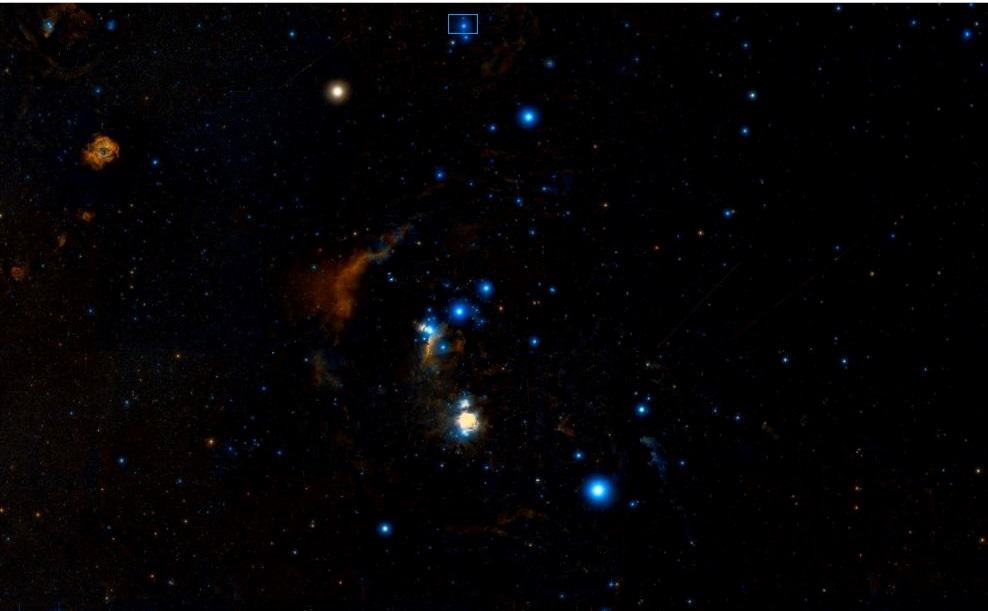
The name, Meissa, only applies to the primary star, Lambda Orionis A. The IAU officially approved this name for the star in 2016.
Formation
Meissa is the central member of the open cluster Collinder 69, also known as the Lambda Orionis Cluster or Lambda Orionis Association. The cluster is composed of fourth and fifth magnitude stars which can be seen with binoculars or even with the naked eye.
This cluster formed around 5 million years ago and it is the interstellar medium of which Meissa also came to be. Gravity pulled gas and dust together and gave birth to Meissa.
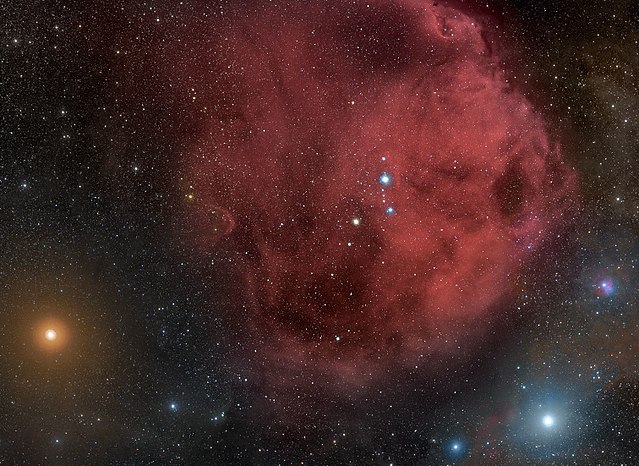
The Lambda Orionis Association orbits through the Milky Way at distances as far as 28,000 light-years from the Galactic Center, and within 25,000 light-years close to it.
It completes an orbit once every 227.4 million years, crossing the galactic plane every 33.3 million years. The other star, Lambda Orionis B appears to be only 1.3 million years old.
Distance, Size, and Mass
Meissa is located at around 1,100 light-years / 340 parsecs away from the Sun. The primary star, Meissa, or Lambda Orionis A, is the bigger star within the star system.
Meissa has 10.0 solar radii, or 1000% of the Sun’s radius, and around 27.9 solar masses, or 2790% of the Sun’s mass. It is around 20 times bigger than our Sun.
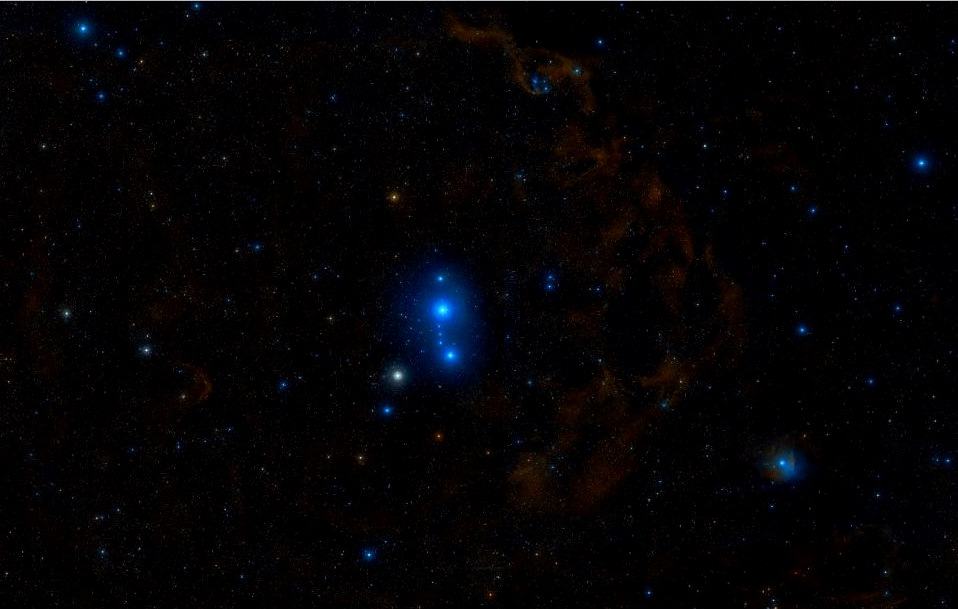
The secondary star, Lambda Orionis B, has 4.2 solar radii or 420% of the Sun’s radius, and 10.3 solar masses or 1030% of our Sun’s mass. It is around 8 times bigger than our Sun.
Other Characteristics
Meissa is a luminous blue giant star of spectral type O8 III. It has an apparent magnitude of 3.54, and it has surface temperatures of around 37,689 K, being 6.5 times hotter than our Sun.
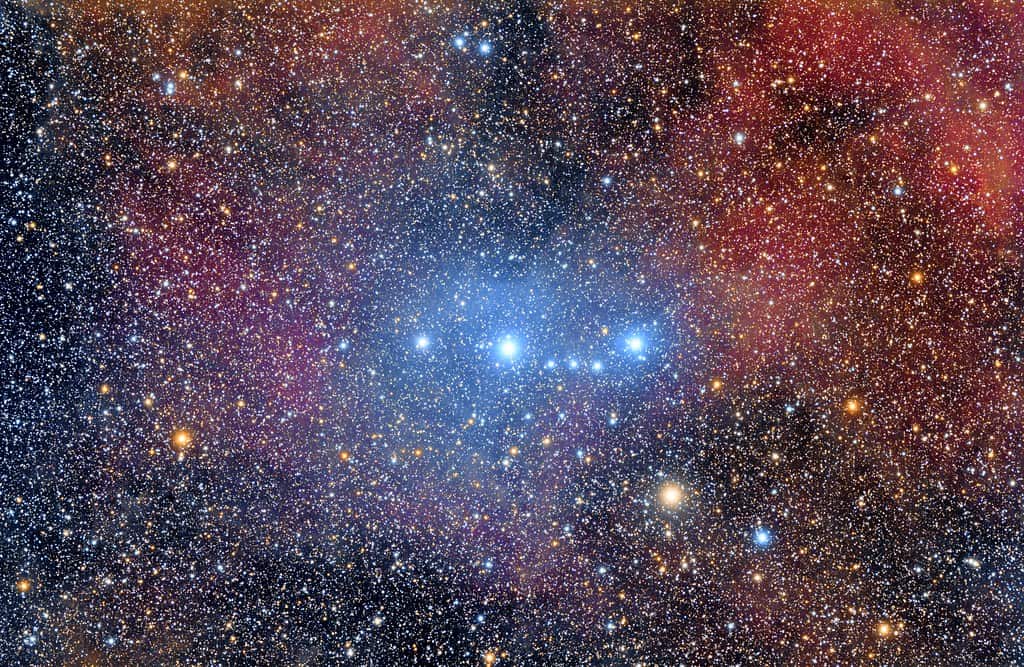
Meissa is also 165,000 times brighter than our Sun, with most of its energy output being in the invisible ultraviolet part of the spectrum. The star is a soft X-ray emitter, indicating the presence of stellar wind.
The secondary star, Lambda Orionis B, is a blue-white main-sequence star of spectral type B0.5 V. Lambda Orionis B has an apparent magnitude of 5.61, being 6.300 times brighter than our Sun. It has surface average temperatures of around 25,400 K, being 4.3 times hotter than our Sun.
Stellar System
The two components of the Lambda Orionis star system are separated by one another at a distance of around 4.41 arcseconds. There is a third component, a main-sequence star that may be a brown dwarf of spectral type F8 V, located at a greater distance from the other two.
Lambda Orionis Ring – Angelfish Nebula
Meissa is surrounded by a ring of nebulosity about 12 degrees across. It is theorized that this nebulosity is the remnant of a supernova explosion.
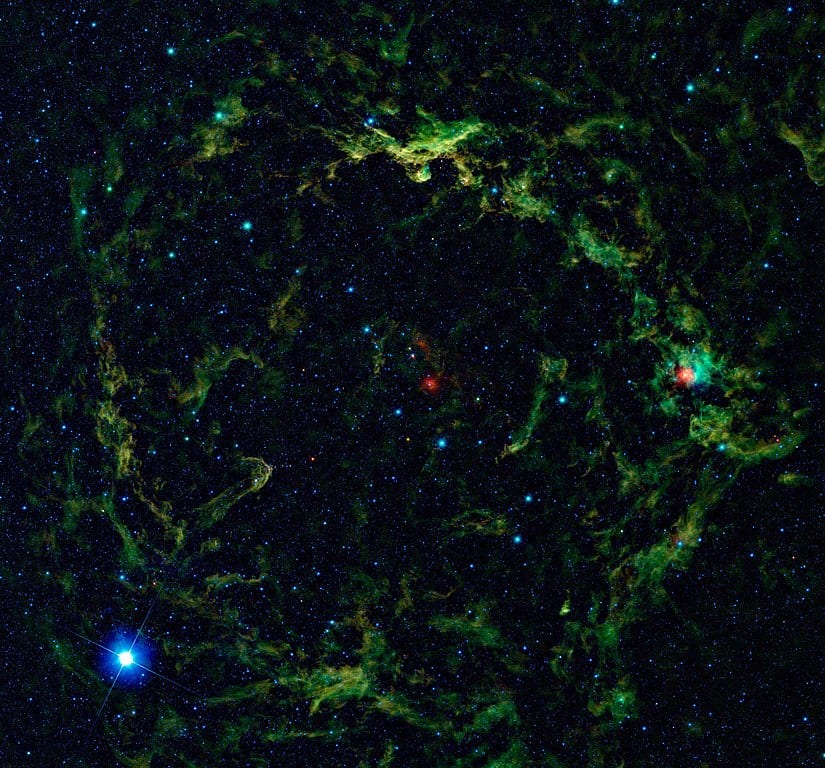
It is illuminated by the ultraviolet light from Meissa and the other hot stars in the vicinity. Lying in the northern part of the Orion Molecular Cloud Complex, the nebula can only be seen in long-exposure images. It isn’t visible in binoculars or small telescopes.
The Lambda Orionis nebula is surrounded by an expanding gaseous ring with an estimated age between 2 to 6 million years. The expansion of the cool gas indicates that the ring may be the remnant of a Type II supernova explosion.
Location
Meissa is located in the constellation of Orion, the celestial hunter, being the 11th brightest star in the constellation. Meissa marks the head of the celestial hunter, while Betelgeuse and Bellatrix mark the shoulders, Alnitak, Alnilam, and Mintaka form Orion’s Belt, while Saiph and the brightest star of the constellation, Rigel, mark the knees or feet.
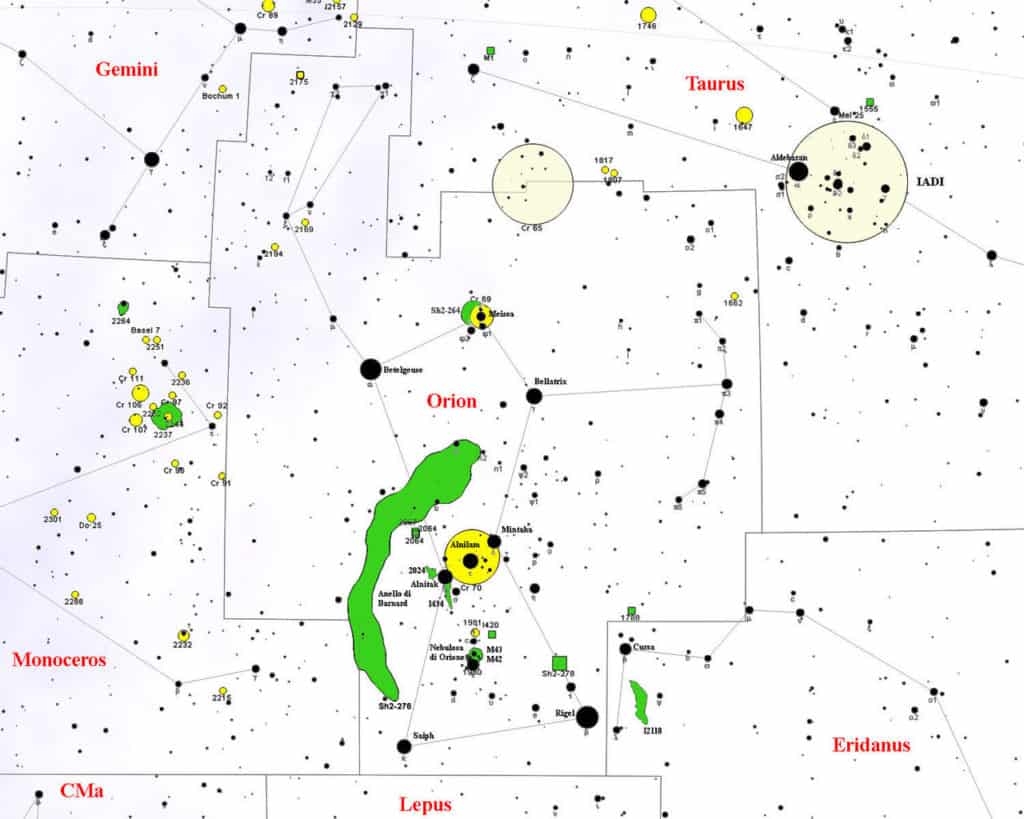
Meissa is easy to find since it sits just above the hourglass shape of Orion, forming a triangle with the bright stars Betelgeuse and Bellatrix. The star is situated near several interesting deep sky objects.
These objects include the planetary nebula NGC 2022, located about a third of the way from Meissa to Betelgeuse, two large H II regions in the neighboring Monoceros constellation, the Rosette Nebula, and the Cone Nebula with the Christmas Tree Cluster – the reflection nebula IC 2169, and the Monkey Head Nebula.
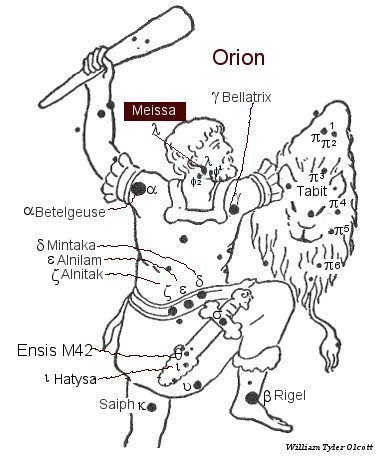
The constellation of Orion harbors several bright stars and deep-sky objects. The best time of the year to observe them is during the month of January.
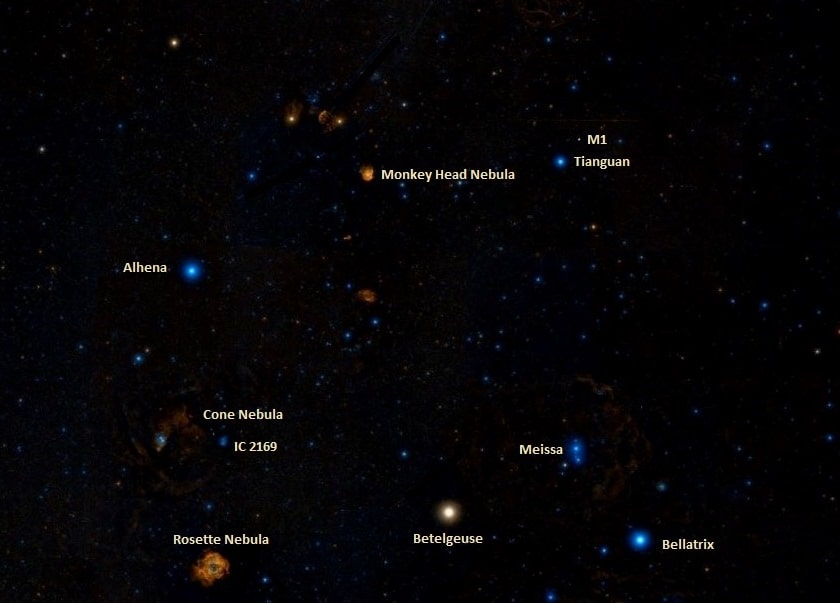
The Future
Like the companion star that exploded as a supernova and now envelops Meissa as a supernova remnant, Meissa is destined to share the same faith.
The star is massive enough to end its life in a great supernova explosion, which will illuminate the sky for some time. A supernova remnant will most likely be left behind after such an event.
Did you know?
- Lambda Orionis was once known as Heka, from Arabic Al Hak’ah – “white spot” – The name refers to the lunar mansion in Arabic astronomy that included Lambda Orionis, Phi1 Orionis, and Phi2 Orionis.
- The Chinese grouped the aforementioned stars in an asterism called Turtle Beak – Meissa is known to the Chinese as the First Star of the Turtle Beak.
Sources:
Image Sources:
- https://www.star-facts.com/wp-content/uploads/2019/09/Meissa.jpg?189db0&189db0
- https://upload.wikimedia.org/wikipedia/commons/thumb/c/ca/Lambda_Orionis.jpg/640px-Lambda_Orionis.jpg
- https://www.star-facts.com/wp-content/uploads/2019/09/Lambda-Orionis.jpg
- https://live.staticflickr.com/472/31239102993_5d66fbfcbb_b.jpg
- https://upload.wikimedia.org/wikipedia/commons/thumb/d/d4/Orion%27s_Big_Head_Revealed_in_Infrared.jpg/826px-Orion%27s_Big_Head_Revealed_in_Infrared.jpg
- https://www.star-facts.com/wp-content/uploads/2019/09/Orion-constellation.jpg?189db0&189db0
- https://www.constellationsofwords.com/images/stars/Meissa.JPG
- https://www.star-facts.com/wp-content/uploads/2019/09/Meissa-Rosette-Nebula-Monkey-Head-Nebula.jpg?189db0&189db0
